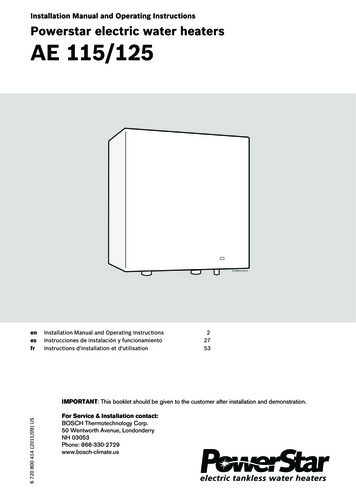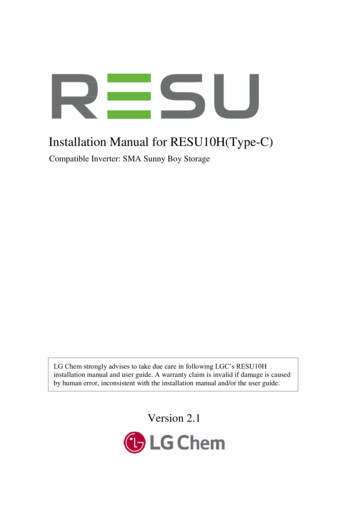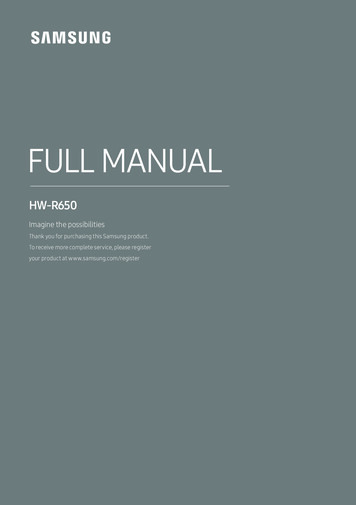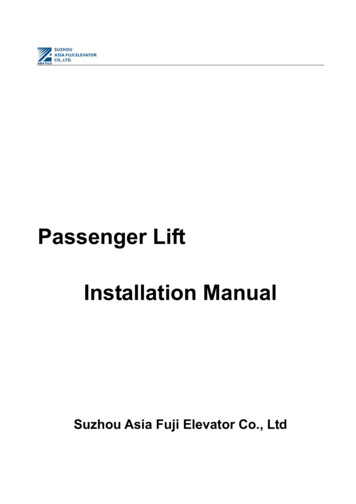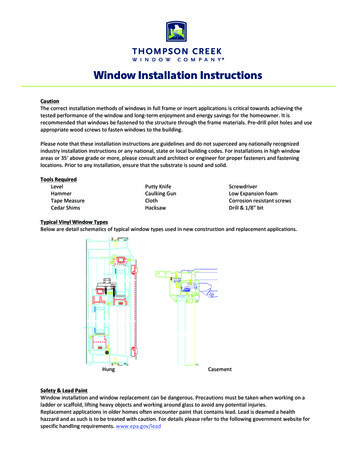
Transcription
LD900Installation and Operations ManualAB-V-MA-00643 RevA529 June 2022
IntroductionContents12345Introduction . 41.1General information . 41.2LD900 receiver. 41.3VERIPOS Support . 51.4Activating VERIPOS correction services . 51.5Terms and abbreviations . 61.6Document conventions . 81.7LD900 notices . 91.8Disclaimer . 121.9Equipment care . 13Hardware overview . 142.1System overview . 142.2Hardware models . 142.3Interface and connectors . 15LD900 installation . 183.1Schematic examples . 183.2Rack mount formats . 213.3LD900 location guidelines . 243.4LD900 mounting. 243.5Ventilation requirements . 253.6Antenna installation. 253.7Cable installation. 28Configuration and operations . 304.1Start-up . 304.2Front panel interface . 304.3Menu & navigation basics . 304.4Status (LD900L model) . 314.5Status (LD900 & LD900M models) . 314.7Configuration. 364.8Receiver . 554.9Help & Support. 60Troubleshooting . 615.1Hardware issues . 615.2Power issues. 615.3Activation issues . 615.4L-band signal issues . 62LD900 Installation and Operations Manual2
Introduction675.5GNSS signal issues . 625.6Corrections issues . 635.7GNSS heading issues . 635.8INS issues . 64Reference information . 656.1Technical specifications . 656.2Cabling and connectors . 676.3Veripos H70 PC specifications . 696.4LD900 output sentences . 70Contact information . 867.18VERIPOS Support details . 86Appendix . 878.1Summary specification of antennas . 878.2Summary specification of cabling . 898.3Default system settings . 918.4L-band coverage map . 92LD900 Installation and Operations Manual3
Introduction1 Introduction1.1 General informationThis document provides the information required to install and operate the Hexagon VERIPOS LD900 receiver.To assist with LD900 installation and operation, it will help to have the following items available when consultingthis document: LD900 and associated equipment shipped to site.The Delivery note provided within the shipment.VERIPOS document Antenna and Coaxial Cable Installation.LD900 FAQs and Quick Guides, available from https://help.veripos.com.1.2 LD900 receiverThe LD900 is a scalable integrated positioning sensor, operable as a basic L-band demodulator or configurableto meet demanding offshore positioning requirements as a fully integrated mobile positioning unit with a multifrequency GNSS receiver. Key system features: Supports decimetre level multi-constellation positioning with VERIPOS Apex and Ultra PPP solutionservicesCompatible with VERIPOS Quantum softwareEN60945 Marine Certified555 channels, multi-constellation, multi-frequency trackingSimultaneously track up to three L-band correction service satellitesFeatures advanced signal filtering to mitigate the effects of interference and spoofingSupports RTK operationsMultiple communication interfaces for easy installationOptional ALIGN GNSS heading solutionOptional SPAN INS solutionOptional MSK Beacon receive corrections from IALA marine radio beacon networkOptional UHF receiver for reception of correctionsOptional 7 Port expansion unit19 Inch rack mount options (for single or dual LD900 systems)1.2.1 PreambleThe purpose of this manual is to provide the information necessary to install and operate the LD900.This manual includes the following sections:1. Introduction - Details the purpose of the manual, conventions and abbreviations.2. Hardware overview - Describes the LD900 interface panel and provides technical data.3. LD900 installation - Covers the installation of the LD900 and provides antenna & cabling guidelines.4. Configuration and operations - Details system configuration and operations via the MMI.5. Troubleshooting - Provides steps on how to rectify system issues that a user may encounter.6. Reference information - Provides detailed technical specifications.7. Contact information - Contains contact information for VERIPOS Support.8. Appendix - Provides additional supplementary material.LD900 Installation and Operations Manual4
Introduction1.3 VERIPOS SupportVERIPOS Support is a service provided as the first point of contact for all VERIPOS technical support and faultreports. It is available 24 hours a day, 365 days per year. For contact details, see the Contact informationsection, the LD900 product label located on the top of the unit or the LD900 MMI Help & Support page.For support cases, make contact via support@veripos.com or raise a ticket at https://help.veripos.com. Witheither method, the VERIPOS Support will be immediately notified and can begin providing assistance.VERIPOS Support will provide initial support and may, if necessary, escalate tickets to regional on-callengineers to provide more in-depth technical support.To aid support, upon first contact, please provide the following: Details of the issue or questionVessel nameCompany nameTelephone numberUnit user codeVERIPOS hardware typeVERIPOS software typeOperating areaIs this issue holding up operations?Any other relevant information1.4 Activating VERIPOS correction servicesCorrection services for the LD900 are provided on a subscription basis by VERIPOS.To activate VERIPOS services, the user must first send a service activation request (containing the unit usercode, vessel name, SAL number and services required) to VERIPOS Support. Support will then send theactivation via an L-band satellite to the unit. Upon activation, the unit will start using VERIPOS services.When not required, some service agreements may allow for service deactivation.NOTETo use VERIPOS services, a contract between the users’ company and VERIPOS must be in place.VERIPOS refers to this as a Service Access License (SAL).To avoid delays, users should record and provide the SAL number associated with the VERIPOSequipment.VERIPOS Support is unable to activate any equipment unless an active SAL exists.LD900 Installation and Operations Manual5
Introduction1.5 Terms and MHzMMMMINMNMEANTRIPOhmPDOPPPPPPSPRNPWRAlternating currentVERIPOS high accuracy positioning solutionAntenna reference pointAmerican wire gaugeChinese commissioned GNSSA bayonet type of RF coaxial connectorComputed minus observedCentimetreDecibelDecibel (microVolts)Direct currentDifferential GNSSDifferential GPSDynamic host configuration protocolDilution of precisionDynamic positioningDifferential quality indicatorEuropean standardEuropean UnionFederal Communications CommissionEuropean commissioned GNSSGlobal navigation satellite system - Russian commissioned GNSSGlobal navigation satellite systemGlobal positioning system - United States commissioned GNSSHorizontal dilution of precisionHigh dynamic rangeHertzIdentificationInternational Electrotechnical CommissionInstitute of Electrical and Electronics EngineersIntegrated mobile unitInertial navigation systemInternet protocolInternet protocol version 4KilogramKilohertzPound (unit of measuring weight)Local area networkSignal transmitted to carry correction data to mobile usersLight emitting diodeLow noise amplifierThird party broadcasting service also referred to as 'MF' or 'Beacon'MegahertzMillimetreMan machine interfaceN-Type (male) coaxial connectorNational Marine Electronics AssociationNetworked transport of RTCM via internet protocolUnit of electrical resistancePositional dilution of precisionPrecise point positioningPulse per secondPseudo random noisePowerLD900 Installation and Operations Manual6
IntroductionQZSSRFRJ45RTCMRTKsSALSAL VDCVDOPVSATWEEEWi-FiQuasi-zenith satellite system - Japanese commissioned GNSSRadio frequencyA physical network interface standard used in telecommunicationsRadio technical commission for maritime servicesReal-time kinematicSecondsSerial access licenseSensor actor lineSatellite based augmentation systemVERIPOS single frequency DGPS systemSpace vehicleTransmission control protocolA threaded type of RF coaxial connectorA threaded type of RF coaxial connector (male)Universal asynchronous receiver-transmitterUser interfaceVERIPOS high accuracy positioning solutionUnified national coarse threadUniversal serial busCoordinated universal timeVoltage alternating currentVolts direct currentVertical dilution of precisionVery small aperture terminalWaste Electrical and Electronic EquipmentIEEE 802.11 (wireless) standardLD900 Installation and Operations Manual7
Introduction1.6 Document conventions1.6.1 Typographical conventionsItalic or bold text is used to emphasize certain information. Italic is also used in cross-references to other partsof the document and to other documents.Bold text is also used for indicators and touch screen “push-buttons” commands.Blue text is used for hyperlinking to other sections within this document or to external documents or websites.Bold italic text is used when display screens are mentioned in text.Monospace text is used for input/output strings to/from the device.1.6.2 Special noticesWARNINGA warning indicates the risk of bodily harm or serious damage to the hardware.CAUTIONA caution indicates the risk of damaging the hardware or adversely impacting theoperation of the system.NOTEA note contains important information to help you make better use of the system.LD900 Installation and Operations Manual8
Introduction1.7 LD900 noticesThe following notices apply to the LD900:1.7.1 Waste electrical and electronic equipmentThe Waste Electrical and Electronic Equipment Directive (hereinafter referred to as the “WEEE directive”)places an obligation on EU-based manufacturers, distributors, retailers and importers to take-back electronicsproducts at the end of their useful life. A sister directive, RoHS (Restriction of Hazardous Substances)complements the WEEE directive by banning the presence of specific hazardous substances in the products atthe design phase. The WEEE directive covers all VERIPOS products imported into the EU as of August 13,2005. EU-based manufacturers, distributors, retailers and importers are obliged to finance the costs of recoveryfrom municipal collection points, reuse, and recycling of specified percentages per the requirements containedin the WEEE Directive.Instructions for disposal of WEEE by users in the European UnionProducts which have the undernoted symbol located on either the product itself or its packaging indicates thatthe product must not be disposed of with other waste. Instead, it is the user’s responsibility to dispose of theproduct by handing it over to a designated collection point for the recycling of WEEE. The symbol shown belowis on the product or on its packaging, which indicates that this product must not be disposed of with other waste.Instead, it is the user’s responsibility to dispose of their waste equipment by handing it over to a designatedcollection point for the recycling of waste electrical and electronic equipment.The separate collection and recycling of your WEEE at the time of disposal will help to conserve naturalresources and ensure that it is recycled in a manner that protects human health and the environment. For moreinformation about recycling centres, please contact the local city office, the household waste disposal service orthe product supplier.LD900 Installation and Operations Manual9
Introduction1.7.2 FCCThis device complies with part 15 of the FCC Rules. Operation is subject to the following two conditions: (1) thisdevice may not cause harmful interference, and (2) this device must accept any interference received, includinginterference that may cause undesired operation.LD900 has been tested and found to comply with the radiated and conducted emission limits for a Class Bdigital device. The Class B limits are designed to provide reasonable protection against harmful interference in aresidential installation.The equipment listed generates, uses and can radiate radio frequency energy and, if not installed and used inaccordance with the instructions, may cause harmful interference to radio communications. However, there isno guarantee that interference will not occur in a particular installation. If this equipment does cause harmfulinterference to radio or television reception, which can be determined by turning the equipment off and on, theuser is encouraged to try to correct the interference by one or more of the following measures: Re-orient or relocate the LD900 Increase the separation between the equipment and the LD900 Connect the equipment to an outlet on a circuit different from that to which the LD900 is connected Consult VERIPOS for helpCAUTIONTo maintain compliance with the limits of a Class B digital device, you must use shielded interfacecablesWARNINGThe LD900 has been authorised for use in mobile applications. At least 20 cm (8 inches) of separationbetween the LD900 and the User must be maintained during normal operation.WARNINGChanges or modifications to this equipment, not expressly approved by VERIPOS could void theuser’s authority to operate this equipment.1.7.2.1Wi-FiLD900 contains a Wi-Fi radio with the following approval: FCC ID: Z64-WL18SBMOD (USA)LD900 Installation and Operations Manual10
Introduction1.7.3 European Union / United Kingdom (UK)1.7.3.1Radio Equipment DirectiveVERIPOS declares that the LD900 including its Wi-Fi transceiver is in compliance with1.EU Directive 2014/53/EU2.UK Regulations S.1. 2017/1206Radio Information:Description of Service: Wi-Fi (802.11b/g/n)Operational Frequency: 2412 MHz to 2462 MHzModulation: OFDMRated Power: 16.38 dBmThe full text of either the UK or EU Declaration of Conformity may be obtained from VERIPOS upon request.1.7.3.2ROHSThe LD900 is in conformity with Directive 2011/65/EU of the European Parliament and of the council of 8 June2011 on the restriction of the use of certain hazardous substances in electrical and electronic equipment.1.7.3.3ReachThe LD900 is compliant with Regulation (EC) No. 1907/2006 of the European Parliament and the Council of 18December 2006 concerning the Registration, Evaluation, Authorization and Restriction of Chemicals (REACH).The candidate list of Substances of Very High Concern (SVHC) published by the European Chemical Agency(ECHA) is available at: https://echa.europa.eu-/candidate-list-table.LD900 Installation and Operations Manual11
Introduction1.8 DisclaimerVERIPOS Limited (hereinafter referred to as “VERIPOS”) has taken every care in the preparation of the contentof this Manual (“Manual”). This Manual and its contents are provided “as is” without any representations orwarranties, express or implied. VERIPOS makes no representations or warranties in relation to this Manual andthe content provided herein, including but not limited to the safety, suitability, inaccuracies or typographical errorsof this Manual. There are inherent dangers in the use of any software (including any firmware), and the end useris solely responsible for determining whether the relevant software provided by VERIPOS and this Manual arecompatible with the end user’s equipment and other software installed on such equipment. End user is also solelyresponsible for the protection of equipment and the backup of data.VERIPOS reserves the right at its sole discretion, but without any obligation, to make amendments orimprovements to, or withdraw or correct any error(s) or omission(s) in any portion of the Manual without notice.Although VERIPOS makes a reasonable effort to include accurate and up to date information, VERIPOS doesnot warrant or represent that this Manual and its contents are current, complete, accurate and/or free from errors.VERIPOS does not accept any responsibility or liability for the accuracy, content, completeness, legality orreliability of this Manual and the content provided herein.If you have any questions or comments about this Manual or our Privacy Policy, please contact us at:support@veripos.com.The LD900 hardware and associated software is subject to VERIPOS Terms and Conditions Relating to theProvision of VERIPOS Services.The software described in this document is furnished under a licence agreement and/or non-disclosureagreement. The software may be used or copied only in accordance with the terms of such agreement. It is againstthe law to copy the software on any medium except as specifically provided for in the license or non-disclosureagreement.Copyright 2022 VERIPOS Limited. All rights reserved.No part of this Manual and its contents may be reproduced, copied, re-engineered, adapted, redistributed,published, commercially exploited or transmitted in any form, by any means, electronic or mechanical, includingphotocopying or recording, without the express prior written permission of VERIPOS. Applications for any writtenpermission should be addressed to VERIPOS House, 1B Farburn Terrace, Dyce, Aberdeen, AB21 7DT, UnitedKingdom.Unauthorised reproduction, copying, re-engineering, adaptation, redistribution, publication or commercialexploitation of this Manual or its contents may be subject to civil as well as criminal sanctions under the applicablelaws. VERIPOS will aggressively protect and enforce its intellectual property rights to the fullest extent, which mayinclude seeking all available remedies in the civil or criminal courts if necessary. Where reproduction, copying, reengineering, adaptation, redistribution, publication or commercial exploitation of this Manual or its contents hasbeen permitted by VERIPOS in accordance with this disclaimer, then no changes in the Manual or deletion of anykind to the Manual may be made. You acknowledge that you do not acquire any ownership rights by accessing,viewing or utilising this Manual and agree that you shall not hold itself out to any third party as having anyownership rights to this Manual.You further agree to save, indemnify, defend and hold VERIPOS harmless on written demand, from all claims,losses, damages, costs (including legal costs), expenses and liabilities of any kind and nature, invoked againstVERIPOS by any third party, for or arising out of, any alleged infringement of any proprietary or protected rightarising out of or in connection with your utilisation of this Manual and/or in connection with any representationmade by you to third parties of ownership of any kind with respect to this Manual.VERIPOS is a trademark of VERIPOS Limited and/or its licensors. All other marks used herein are trademarksof their respective holders. All other marks used herein are trademarks of their respective holders. Veripos Limitedis part of the Hexagon Autonomy and Positioning division of companies of Hexagon AB.LD900 Installation and Operations Manual12
Introduction1.9 Equipment care1.9.1 Unpacking and inspectionCarefully unpack and inspect the equipment, verifying receipt of all major items and ancillary equipment. If anyitems are missing, contact VERIPOS or the system supplier as soon as possible. If the equipment appearsdamaged, contact VERIPOS for further advice ensuring to retain the original packaging. Responsibility fordamage to items returned without the use of approved packaging will not be accepted.1.9.2 InstallationDuring installation: Ensure DC power supply is disconnected. The power connection is accessible on the unit rear.Secure the unit using the holes in the base plate. Position the unit to ensure ample spacing foraccess to the front interface panel and adequate ventilation during normal operation.Route cables safely to avoid sharp edges, excessive bends and pinches.Only use the cables specified within this manual for interconnection of the equipment.Connect the equipment to the ships ground.1.9.3 Safety warningsAlways observe the following safety precautions: Ensure adequate air circulation to ventilate the unit, especially to the sides, to avoid heat build-up.Connect only to a power supply with a voltage within the range of 12V to 24V DC.Always disconnect the LD900 from the power source when connecting equipment.Never use the equipment in damp conditions.Avoid excessive heat, humidity, dust or vibration.Do not use in proximity to dripping or splashing liquids.Always use the power connections supplied with the unit.Before replacing a fuse, disconnect the equipment from the power source.1.9.4 MaintenanceClean the unit using a clean, dry cloth only. Do not wet the unit or allow the penetration of water. Do not usesolvents to clean the unit.1.9.5 ServicingThis unit contains no user-serviceable parts. Please refer all repairs to a qualified service agent or VERIPOS.1.9.6 Fault diagnosisFollow the guidance in this document to correctly install the LD900. If issues arise, firstly, check all connectionsbefore contacting your supplier or VERIPOS for assistance.LD900 Installation and Operations Manual13
Hardware overview2 Hardware overviewThis section provides an overview of the LD900 receiver and details the physical characteristics of the systemand the different models.2.1 System overviewThe LD900 is a high precision system built into a rugged enclosure and designed to operate reliably in the mostdemanding of marine environments. The LD900 is available in three separate models and is upgradable asrequired to provide any VERIPOS positioning solutions. Key model-dependent system features include: Multi-channel L-band reception supporting all VERIPOS correction servicesMulti-constellation GNSS system with a quad-frequency capabilityDual antenna inputs for headingMultiple RS232 / RS422 portsDual Ethernet portsFront panel display UIIntegrated data loggingOptional INS2.2 Hardware modelsThe product label on top of the LD900 will indicate the model, with the system available in three models:ModelReceiver modulesLD900LL-bandLD900L-band, GNSSLD900ML-band, GNSS & MFBoth the LD900 and LD900M models are capable of GPS, GLONASS, BeiDou, Galileo and QZSS multiconstellation tracking. The constellations used in the calculated solutions will depend on the use of theappropriate activated VERIPOS services.LD900 Installation and Operations Manual14
Hardware overview2.3 Interface and connectorsThe LD900 features a 3.5” colour MMI with keys to navigate the UI, allowing user configuration and statusmonitoring.2.3.1 Front panel interfaceThe LD900 front panel provides a display UI, controls and USB 2.0 port for system updates and data archiving:2.3.2 Rear panel connectorsThe LD900 rear panel has several RF and data connectors for interfacing with the unit:LabelConnectorDescriptionGNSS1TNCPrimary GNSS connector. Used to generate the receiver position andavailable as means of L-band signal reception.GNSS2TNCSecondary GNSS antenna. Only used for GNSS heading systems togenerate a heading in relation to the GNSS1 antenna.LBANDTNCDefault L-band antenna connectorBEACONTNCMF antenna connectorPPSBNC1PPS outputCOM1, COM2, COM3DB9RS-422/RS-232AUXDB15For connection to UHF module.LAN1RJ45Ethernet network 10/100Mbps for interfacing.LAN2RJ45Ethernet network 10/100Mbps for connection to QuantumPWRSAL M12 4 Pin12 to 24 VDC power inputLD900 Installation and Operations Manual15
Hardware overview2.3.2.1Serial portsThe LD900 has three serial ports: COM
When not required, some service agreements may allow for service deactivation. NOTE To use VERIPOS services, a contract between the users' company and VERIPOS must be in place. VERIPOS refers to this as a Service Access License (SAL). To avoid delays, users should record and provide the SAL number associated with the VERIPOS equipment.



